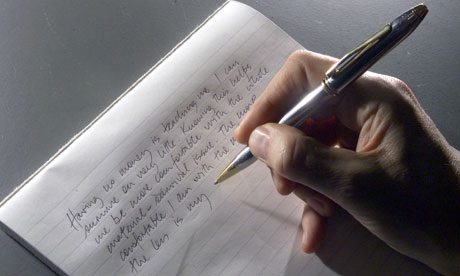How To Improve Your Handwriting Skills
- Set a good and a smart goal. This will give you the motivation to improve handwriting.
- Before trying to learn specific forms or shapes of the letters, try writing in the air (imaginary) or writing on a white board. Try writing while not moving your Fingers or wrist.
- Look For the other people handwriting to get better ideas.
- Practice writing the letters when you are very comfortable while making the shapes used in them.
- Find your own style and make your own alphabets pattern.I know it is the most difficult task but you have to do it in order to get beautiful handwriting.
- Write everything longhand that you think of , Avoid writing on a type writer or using a PC keyboard.
- Experiment with different types of pen like wide markers, Thin nip markers, Ink Pens, Pointers, Ballpoints,and even with calligraphy pens .
- Try writing different form for the single letter. This help you to make decision to write the most beautiful letter .
- Try out different mediums.
- Print out the elementary school handwriting charts.
- Believe in yourself and motivate yourself that you can do something.
Table of Contents
Tips to improve your handwriting
- Try writing the letters of equal size.
- Do not grip the pen too hard.
- Keep on writing “The quick Brown Fox Jumps over the lazy dog” in small and capital letters.
- Keep a page of you written in good handwriting for inspiration.
- If you don’t like the way of what you wrote .Erase It.
- Don’t get angry if you didn’t achieve the handwriting that you wanted , Else try hard to get that.
- Different types of pens and pencils work better with some people , So avoid trading the pen with your friends.
- Try to keep your wrist straight when you are writing
- Re-Writing the guide is an also a excellent way of improving hand writing.
- Try to write one paragraph or two each day , This helps you to improve your handwriting skills.
Warnings
- Do not press the nip of your pen hard when writing onto the paper, You will develop writer’s cramp.
- Don’t throw away any of your templates or sheets , you would need them for guideline later.
- If tracing on the computer monitor, do not trace too hard or else your computer Monitor would be going to have scratches. Tips for improving your handwriting You’ve decided you want to improve your handwriting and you’re probably hoping a fountain pen will do the trick — maybe a friend told you it would. Maybe you’re just adventurous and you want to try your hand at calligraphy (or you might, once your handwriting improves).
Good for you! A fountain pen may make your writing look a bit better, but if your writing looks as if frenzied chickens got loose on the page, chances are this won’t be enough. Most likely, you’ll need to retrain your arm and hand.
After coaching handwriting and teaching calligraphy over the years, I’ve learned to see the characteristics of those who’ll be able to pick up the necessary motions quickly from those who’ll have to work a bit harder. Crampy, uneven letters are often the result of drawing the letters with the fingers rather than using the whole arm to write.
People who inevitably have trouble with handwriting and calligraphy write with their fingers. They “draw” the letters. A finger-writer puts the full weight of his/her hand on the paper, his fingers form the letters, and he picks his hand up repeatedly to move it across the paper as he writes. If you use the right muscle groups, your writing will have a smooth, easy flow and not look tortured. People for whom writing comes more easily may rest their hands fairly heavily on the paper, but their forearms and shoulders move as they write.
Their writing has a cadence that shows they’re using at least some of the right muscle groups. They don’t draw the letters with their fingers; the fingers serve more as guides.
This exercise may help you determine which category is yours:
Sit down and write a paragraph. Doesn’t matter what. Pay attention to the muscles you use to form your letters. Do you draw each letter with your fingers? Pick your hand up repeatedly to move it? Have an unrecognizable scrawl? Does your forearm move? Chances are, if you learned to write after 1955-60 (depending on where you went to grade school), you write with your fingers.
My goal isn’t to make you into a model Palmer-method writer or a 14th Century scribe. If you can compromise between the “right” methods and the way you write now and improve your handwriting so you’re happier with it, then I’m happy, too.
A few people hold the pen between first and middle fingers, which feels really awkward to me, but I’ve seen it work. It will take time to re-train muscles and learn new habits. Finger-writing isn’t fatal, but it is slow and often painful (if you have to write much).
The first thing you must have (beg, buy, borrow or steal it) is patience and gentleness with yourself. The second requirement is determination. If you finger-write, that is the first, most important thing you must un-learn: Do not draw your letters! Do not write with your fingers! Put up signs everywhere to remind you.
Write it in the butter, on the shaving mirror, stick notes in the cereal boxes. But learn it! I hesitate to include this, because it sounds much more difficult than it is . . . but . . . let’s look at the most basic things: holding the pen and positioning the hand. Fig.
1. This is the most common pen-holding position, with pen between first and middle fingers, held in place by the thumb. Most of us hold the pen between the thumb and index finger, resting the barrel on the middle finger (fig. 1).
This works better than holding it between the thumb and the index and middle fingers, with the whole assembly resting on the ring finger (fig. 2). If you do it the first way, you’re off to a good start. If the second, you’ll be okay. In both, the remaining fingers are curled under the hand. Fig.
2. The two-fingers-on-top method for holding the pen while writing. Pick up your pen and look at your hand. You’ll have better control and a better writing angle if your pen rests over or just forward of the bottom knuckle on your index finger, not between thumb and index finger (see fig. 3). (I hold my fountain pens in the latter position, but when I pick up a calligraphy pen, it drops obediently right over that big knuckle–go figure!) Fig.
3. Note that with this position, usually used for calligraphy (or among really disciplined writers), causes the pen to rest atop the knuckle of the forefinger. For handwriting, the pen position is less important than for calligraphy.
I recommend working in your familiar position unless it’s really bad. What’s essential is that you be comfortable, the pen feel balanced and you have no tension in your hand. Rest the heel of your hand and the angle of your curled-up little finger on the paper.
Hold the pen lightly; don’t squeeze it. Pretend the barrel is soft rubber and squeezing will get you a big, fat blot. (If you were using a quill, you’d hold it so lightly that the actual act of drawing the quill along the paper would create the proper contact.) Many books recommend you write with your table at a 45-degree angle, but that’s impractical for most of us. If you can prop up a board or write with one on your lap, that’s a good place to start, but a flat surface is fine.
Once you try an angled surface, you’re likely not to want to quit, so be careful– here goes a whole new budget’s worth of art supplies! Sit up straight, but not stiffly; don’t sit hunched over or slumped. Don’t worry too much about this position stuff; the important thing is what makes you feel relaxed and comfortable. Your writing arm needs to be free to move, so squished into the La-Z-Boy probably won’t be productive. Hold your fingers fairly straight and write slightly above and just between your thumb and index finger, right where you’re holding the pen. Don’t curl your hand over and write to the left of your palm; that’s a crampy, miserable position. More lefties do this than righties.
Commonly called the “hook” position, this is often seen in left-handers. It makes it harder, but not impossible, for them to use a fountain pen, because their hands tend to drag over the wet ink. When you’re practicing and you reach the level on the paper at which it becomes uncomfortable to continue to move your hand down the paper to write, move the paper up. Once you recognize your “writing level,” the paper should move up at that spot rather than your hand moving down the paper. (This isn’t critical. If you notice it and it bothers you, that’s what you do about it. If it doesn’t bother you, skip it.) I’ve found only one reference to using the right muscle groups to write, and this is critical.
I can’t be the only person who knows this; I’m neither that smart nor that good. Calligraphy instruction books address hand position, desk position, lighting, paper, you name it–but for some reason, not using the right muscles. As you’ve probably surmised, the “right muscles” are not those in the fingers. You must use the shoulder-girdle and forearm muscles. This muscle group is capable of much more intricate action than you think and tires much less easily than fingers, besides giving a smooth, clean, sweeping look to the finished writing. Though it seems paradoxical, since we’re accustomed to thinking of small muscles having better control, the shoulder-girdle group, once trained, does the job better.
To get a feel for the proper muscles (and start training them correctly), hold your arm out in front of you, elbow bent, and write in the air. Write big. Use your arm and shoulder to shape letters; hold your forearm, wrist and fingers stationary and in writing position. You’ll feel your shoulder, arm, chest and some back muscles doing most of the work. That’s good.
That’s what they’re supposed to do. Try to duplicate it each time you practice. People always look puzzled when I mention the shoulder girdle. If you raise your hand in the air and make large circles, note the muscles you use in doing so (here, shown in darker pink). That’s the shoulder girdle. Write in the air until it becomes as natural as breathing. It’ll be awkward and feel silly at first. If you have a little kid around, get him/her to do it with you.
You’ll both have fun, you won’t feel so alone, and it’ll be good for the child’s handwriting, too. If you don’t have a kid, tell your co-workers you’re improving your financial karma or hexing your boss. As you become comfortable, reduce the size of the air-letters you make. If you have access to a chalkboard or a stick and a fence (or even a finger and a wall), write on them. They’ll give you a feel for the muscles you need to use and writing on a vertical surface makes it virtually impossible to finger-write.
(If you’re one of the people who can’t write on a blackboard because you keep wanting to shrink the writing down so your fingers can do it, this is really important for you.) If you keep wanting to hunch up close and put your hand on the chalkboard or wall to write, resist the urge! You’ll be indulging those dratted fingers.
Remember
Your fingers should move very little and your wrist even less. Your forearm does most of the guiding, while your shoulder provides the power. At some point, you’ll want to try this with a pen. Hold it gently. Place it on the paper in an ordinary lined spiral notebook (the lines act as ready-made guidelines for size and spacing).
If you can get hold of a first-grader’s Big Chief tablet, which offers big lines with a dotted line between two bold lines, use it. There’s a reason children start out writing big and the letters get smaller as they get older and more skilled—-that’s the easiest way to learn. Start making Xs and ///s and \\\s and OOOOs and overlapped OOOs and spirals and |||||s. Do not draw these strokes and figures! Use the same shoulder-forearm muscles you’ve been practicing with. Make your lines, loops, circles and spirals freely.
Work into a rhythm and make it a habit. When you start making slashes and circles, they’ll be uneven. With practice, they’ll become more uniform, and uniformity is your objective. Your goal is smooth, uniform, evenly spaced lines, loops, circles and spirals, without drawing them. This is where you’re most likely to get discouraged. If you use a spiral notebook for practice, you can leaf back and see your progress. At first, your strokes and lines will be bad—over-running and under-running the lines, too small, too big, crooked, uneven, just ugly. Check your position; check your muscle groups; and try again. And again.
Concentrate on keeping wrist-hand-fingers largely stationary and in proper alignment. Let the big muscles do the work. It will be more tiring at first, because you’re using muscles that aren’t accustomed to that kind of work. It’ll be hard and frustrating, ’cause your body will want to do it the way it’s done it since first grade… even though that way is wrong.
It may help to concentrate less on the accuracy of the shapes you’re making than on the muscles making them. Retraining your arm is the goal, not making pretty little circles and lines first time out. Uniformity and consistency are your aim in all the exercises, whether loopy or slashy. Though it seems uncomfortable, these exercises will make a huge difference in your control and smoothness. When you start putting the strokes and lines on paper, start out big. Three, four, even more lines in your notebook.
(Big Chiefs are handy for this.) This helps ensure that you continue to use the shoulder girdle. Don’t try to make pretty letters at this stage. Do the exercises as much as you can—-shoot for every day. Ten or fifteen minutes a day should show results in a few weeks for most people. And note that both air-writing and paper exercises can be doodled-during meetings and while on hold-waiting for somebody! Concentrate on that shoulder girdle.
Let it do the work. Write big. Write words and sentences at the same time you’re doing strokes and exercises. You need both working together to succeed. Gradually, as your control increases, make your strokes and letters smaller until they’re the size you normally write. You’ll know when you get there.
By this time, you probably won’t have to make extra effort to incorporate this stuff into your writing; it’ll be automatic. And your writing should look much better (and be easier and feel better, to boot).



















































